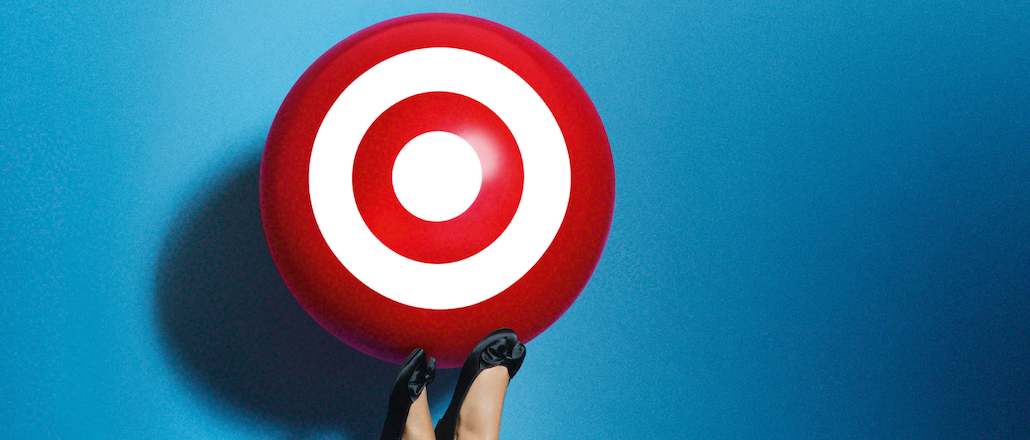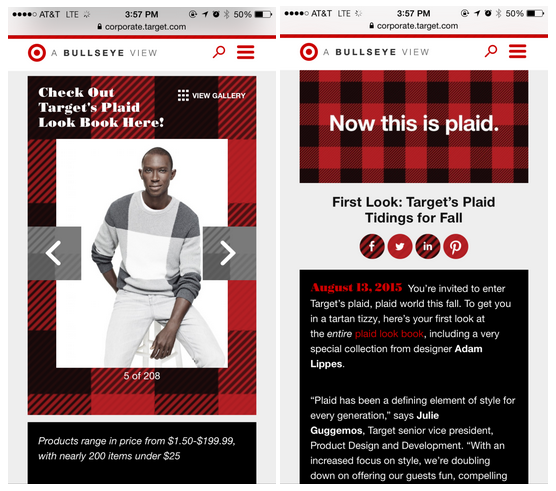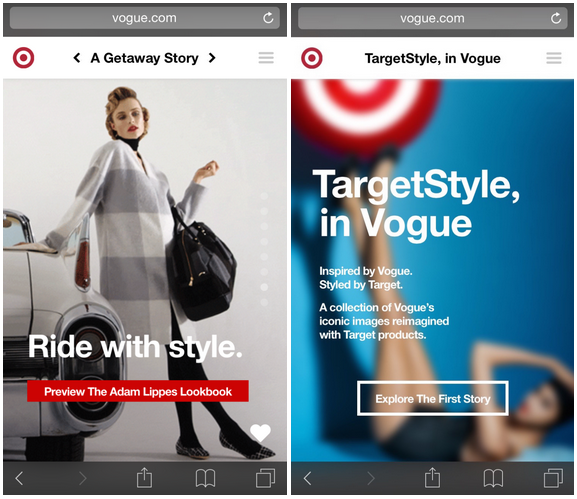Save 50% on a 3-month Digiday+ membership. Ends Dec 5.

The 832 pages of Vogue’s September 2015 issue — which is fronted by a pink-sequined Beyoncé — are stubbornly, defiantly analog.
Target, however, is an exception. This year, the retailer sprung for an imaginative 11-page spread that recreated classic Vogue ads from the past 100 years — using only Target products. To connect with smartphone users, the company, which worked with the agency Mother New York, tapped Shazam to tie its physical pages to extra digital content.
“Making it a digital experience was a top priority for us,” said Target rep Joshua Thomas. “But it also had to be quick, nimble and easy to use.”
In working with audio and visual recognition app Shazam to literally bring the content off the pages of the thick Vogue issue, Todd Waterbury, chief creative officer at Target, said in a blog post that the point was to have the reader “see where we started.”
Readers are encouraged to hold their phone over Target’s ad pages. Shazam then sends them to an interactive display on Vogue.com, showing behind-the-scenes GIFs from the shoot and a shoppable version of Target’s fall lookbook with designer Adam Lippes, as well as the original Vogue photos the ads were inspired by.
Target’s spread was just a hint at the steps advertisers can take in order to bridge the physical world with the digital. But throughout the September issue, the majority of brands are still holding strong to the classic methodology — highbrow imagery labeled with the designer name — without roping in digital elements. Those ads, while beautifully shot, lack a life off of Vogue’s pages. Throughout the entire four-pound issue, we counted six hashtags in the ads and two brands — Buffalo Jeans and Skechers — that prominently displayed their social media accounts.

While Target drove readers to digital content — including a shoppable lookbook — in a highly interactive way, a few other brands pointed to online elements in their advertisements. Gap Kids used its Vogue spot to promote its collaboration with Ellen Degeneres’ lifestyle collection, ED, a partnership based on a social movement to empower young girls. The ad in Vogue encourages readers to text “Ellen” to a five-digit number in order to “hear from Ellen herself” about the collection — while somewhat primitive, it gives the ad legs. The campaign’s hashtag, #heyworld, is also displayed.
Other ads encourage digital action by teasing something off the pages that appeared in the magazine. Lane Bryant, whose “I’m No Angel” campaign promotes its plus-size lingerie line, ran an ad in the issue showing the silhouettes of the campaign’s models, with the hashtag #PlusIsEqual. Not much more information was given, other than a date — Sept. 14, 2015 — the lines “It’s time for change/Be part of it” and the URL PlusIsEqual.com. Nowhere does it say it’s a Lane Bryant ad (but the presence of plus-size women in the notoriously thin pages of Vogue are enough cause for a second glance).
The September issue is, famously, the Super Bowl of fashion — and “multipage print buys just aren’t enough anymore,” according to Jessica Navas, evp at Erwin Penland.
“Brands must have clearer, more distinct points of view that can extend beyond the page in ways that both build on the story and close the deal,” she said. “Target figured out the balance of inspiration and utility for each touchpoint — it’s a great win for them.”

Diane Von Furstenberg also used a teaser to draw eyes to an online feature. Tapping model Karlie Kloss (who is present throughout the entire September issue) for the #DVFSecretAgent campaign, the brand keeps the information in the magazine ad minimal, guiding readers instead to watch the full video, starring Kloss and directed by Peter Lindbergh, online at DVF.com.
It’s not surprising that high-end brands stuck with the traditional when displaying spreads in Vogue’s biggest issue of the year, but techie ads for Apple Watch, Amazon Fashion and Apple Music were among those who also kept their presence limited to the paper.
Even in 2015, the glossy pages of Vogue are still largely unfazed by digital. High engagement with Target’s Shazam ad, however, could change the tide for next September.
More in Marketing

Future of Marketing Briefing: The tells and flops that will define Omnicom-IPG mega holdco
The real story will sit in how this newly fused entity behaves — whether it breaks from the patterns that defined both parents or simply scales them.

In Graphic Detail: CMOs at a crossroads of power and proof
CMOs are closing out another year defined by churn and shifting ground.

As Black Friday nears, fake apologies from brands are all over Instagram
Brands have taken to social media in advance of Bliack Friday to ask followers for forgiveness. The catch: They’re apologizing for their products being too good.





